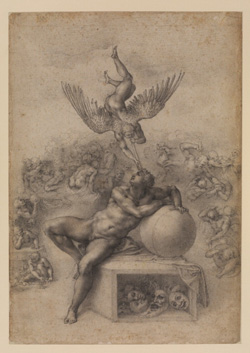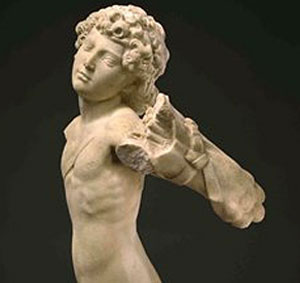Present at the Creation
John Haberin New York City
Michelangelo Drawings
Sometimes even the divine has to struggle with the creation. The Met names a mammoth survey of Michelangelo drawings after his fame within his lifetime, as (only a little quaintly and preposterously) Il Divino. Yet "Michelangelo: Divine Draftsman and Designer" shows an artist who could never rest, not even on the seventh day. In his writings, he valued ease but also difficulty—and grace but also terror. Who can say at any moment which will win out?
The Met takes him from a precocious twelve-year-old, or so it hopes, through the young man determined to outdo the very best of the Renaissance. It finds him struggling on sheet after sheet with projects that he could not bring to completion. It sees him struggling, too, as an older man to earn the affection of others. It ends with drawings as models in the hands of other artists, to extend his legacy to their work. It throws in a few paintings and sculptures, mostly by others, as well. With studies for such monuments of art history as the Sistine Chapel, it allows one to be present at the creation. 
The breadth of the Renaissance
This creation took more than a week, and it sure did not always turn out the way that this god hoped. Yet Michelangelo Buonarroti died in 1564 at eighty-eight, a remarkable age back then, and his range and influence were enormous. Born near Florence, he studied with Domenico Ghirlandaio, one of the city's finest painters. Ghirlandaio had a gift for form, with an eye to drapery and architecture, but also sympathy for the everyday face of the burgeoning middle class, which he captured in portraits. He would have taught Michelangelo to attend to all of these. Not a single drawing from the younger man's workshop days survives, so the Met throws in a few by Ghirlandaio in metalpoint, a demanding medium that Michelangelo, too, surely knew well and that does not permit erasure.
On his own in Florence, a city of art just as today, Michelangelo went back to the very origins of the Renaissance. He copied a monumental figure by Giotto, with crosshatching in small strokes of the pen to create mass, light, and shadow. He copied the Expulsion from Paradise, by Masaccio, with red chalk that accentuates by its very smudges the pain in Adam's or Eve's face. He could not resist firming up their legs and butt muscles as well. A possible but by no means certain first sculpture in marble, a young archer, adapts an early Renaissance bronze while stripping it of decoration and refinement.
His early success in sculpture brought him to Rome, where he grew so close to the pope that Julius assigned him to design his tomb. Julius also overcame Michelangelo's hesitancy to take on painting the Sistine ceiling, while allowing the artist a far more ambitious scheme that either had anticipated. Later Michelangelo played a role in the design of Rome's greatest churches and public squares. He lived to influence not just the High Renaissance, through a close follower in Sebastiano del Piombo, but the late Renaissance as well. He offered a cartoon, or full-scale drawing for transfer, to Jacopo da Pontormo, and the twisted and tormented bodies of his Last Judgment could well stand as Mannerism's greatest achievement. He died at a time of changing morals, to the point that another follower, Daniele da Volterra, took charge of covering up the painting's nudity.
His breadth appears, too, in his media. The Met's description of him as "draftsman and designer" plays on the Italian designo, which means more than just drawing. One might think of Renaissance drawing as a matter of line, but Michelangelo thought of himself as a sculptor, and he created a corresponding sensibility on paper. The early crosshatching loosens up, and firm outlines vanish entirely—and he brought the same sensibility to painting and architecture, both public and private. He also found a language for his art and his longings in poetry, which often shares a sheet with his drawing. Not even Leonardo da Vinci was such a Renaissance man.
A history of the Renaissance cannot help contrasting them. Leonardo, the older of the two by more than twenty years, got things going and then abandoned his art. Michelangelo struggled and persisted to the end. Things came easily to Leonardo, as did the insatiable curiosity that filled notebook after notebook with anticipations of later art and science. He had his charm and resisted the charms of others. Michelangelo was always demanding, always difficult, and always needy.
Still, both were out to have it all. Michelangelo sketches a bird next to another sonnet, and his observation of nature appears more clearly still in his musculature. He could almost be dissecting human anatomy with his pen and his eye. He has incidental overlap with Leonardo, too, as when both proposed equestrian statues with the horse's front feet raised—or when drawing in black chalk of a young man matches the enigma of the Mona Lisa's smile. Most of all, they share a concern for detail within a larger unity. In studies for the pope's tomb or the Medici Chapel, Michelangelo does not set figures or relief elements within architecture, but on a par with it, so that they all serve as occasions for contemplation—and so that they all come alive.
Minding the gaps
Michelangelo's breadth challenges a museum to keep up. The Met responds with more than two hundred objects, including more than one hundred thirty drawings by him alone. It also places a replica of the Sistine ceiling in a light box overhead, somewhat later than it and related drawings would fall chronologically. At a quarter scale, it is more than impressive enough, and it further drives home the artist's unity of site and art. The full-scale reproductions of individual panels this past summer, each on its own stand at the PATH station Oculus, had to leave one wondering if they could ever come together as a narrative, a program, or a work of art. Here they gain in power from the painted ribs that separate them and that ripple across the whole.
The show challenges the viewer all the same. In part, that reflects Michelangelo's struggle. The more he worked on something, it often seems, the less likely it is to have come to an end or to have survived. He eventually came back to and completed the tomb, but then whose art was more drawn to death? Much else worked itself out just fine in paint or stone, with little to no evidence on paper. A single sheet relates obliquely to his David—but not a one to the Pietà, Moses, the Doni Madonna in oil, and ever so much more.
 In part, too, the Met has its gaps because it also has its biases. It trots out the supposed Michelangelo at age twelve, a painting after a Northern Renaissance print, and it looks sillier each and every year. Sure, its harsh edges, alternately pale and leaden colors, action figures out of a modern comic strip, and total separation of foreground and background could reflect his age—but then how certainly did he study the Northern Renaissance as a child, and what makes this Michelangelo? The Met also has to dwell on Young Archer, since the museum houses it. It manages a bust of Brutus from the Bargello in Florence, although an assistant carved much of it, and the Met never so much as hints at its origins in Michelangelo's laments for the Florentine republic in the age of the Medici. He could have pulled together the scale model on display for a dome, but then so could anyone.
In part, too, the Met has its gaps because it also has its biases. It trots out the supposed Michelangelo at age twelve, a painting after a Northern Renaissance print, and it looks sillier each and every year. Sure, its harsh edges, alternately pale and leaden colors, action figures out of a modern comic strip, and total separation of foreground and background could reflect his age—but then how certainly did he study the Northern Renaissance as a child, and what makes this Michelangelo? The Met also has to dwell on Young Archer, since the museum houses it. It manages a bust of Brutus from the Bargello in Florence, although an assistant carved much of it, and the Met never so much as hints at its origins in Michelangelo's laments for the Florentine republic in the age of the Medici. He could have pulled together the scale model on display for a dome, but then so could anyone.
The commentary has its biases, too, for all the lengthy wall labels. The curator, Carmen C. Bambach, introduces another student of Ghirlandaio, who went on to manage Michelangelo's assistants on the Sistine Chapel, but you know how that turned out. If you do not—which is to say you do not know that he fired them after the first section of the ceiling drew moldy, locked the door, and finished the rest on his own—you will not learn it here. The Met also does all it can to dance around Leonardo and Raphael, so as not to steal the show's thunder. It never mentions that Leonardo's cartoon around 1503 for a Madonna inspired a new unity for grouped figures for Michelangelo as well. It does not reproduce Raphael's portrait of Michelangelo along with others, and it does not include Raphael (who labored next door to the Sistine Chapel) among those he influenced so deeply.
That still leaves the struggle, only starting with the literal struggle of Michelangelo's Slaves or unfinished Battle of Cascina. An entire room belongs to Tommaso de'Cavalieri, a young man whose love Michelangelo tried so hard to win. The next room picks up a later friendship, with Vittoria Colonna, with whom he exchanged poetry. Tommaso introduced a franker eroticism to his art, barely disguised behind myths or masks, while Vittoria brought instead a turn to the spiritual. In a late Deposition in stone, an unfinished second Pietà, or a drawing on the same subject, the dead Jesus takes on all the sadness and weight of the flesh. And then there is the exuberance of earlier struggles, as Michelangelo cannot stop drawing and inventing.
He fills a sheet only to turn it sideways, upside-down, or on its reverse to make room for more. He blocks out a figure with separate studies of anatomy, clothing, and architectural setting. He also makes it impossible to know which came first. Does that make his process fundamentally additive, or does he have it all in his head to start? Either way, his unity packs a surprise, and so do his drawings. You may need to come with a little of the story that the Met leaves out, or you may delight in leaping over the gaps.

"Michelangelo: Divine Draftsman and Designer" ran at The Metropolitan Museum of Art through February 12, 2018. Related reviews look at allegations of a youthful Michelangelo, a likely early Michelangelo sculpture, a reproduction of the Sistine Chapel, and Michelangelo among drawings from Munich. I single out Michelangelo drawings in my best of 2017.




